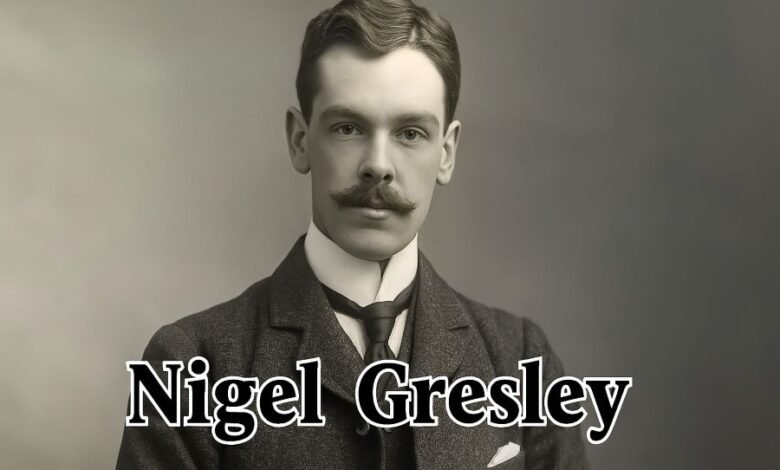Nigel Gresley: The Visionary British Engineer Who Transformed Railway History
The Inspiring Life, Family, and Legacy of Sir Herbert Nigel Gresley — Britain’s Steam Locomotive Genius

Table of Contents
ToggleIntroduction
Sir Herbert Nigel Gresley stands among the greatest names in engineering history — a British engineer whose innovative brilliance reshaped the golden era of steam locomotion. Known for his unmatched mechanical genius, he was the mastermind behind the legendary Mallard, the world’s fastest steam locomotive. His journey from a passionate apprentice to the Chief Mechanical Engineer of the London & North Eastern Railway (LNER) reflects dedication, vision, and a relentless pursuit of perfection.
Nigel Gresley was not just an engineer; he was an artist in steel and steam. Every line of his locomotives reflected both efficiency and elegance. Beyond machinery, he was a devoted family man, a curious mind, and a humble visionary who inspired future generations of railway innovators.
Quick Bio
| Attribute | Details |
|---|---|
| Full Name | Sir Herbert Nigel Gresley |
| Date of Birth | 19 June 1876 |
| Place of Birth | Edinburgh, Scotland |
| Date of Death | 5 April 1941 |
| Nationality | British |
| Profession | Locomotive Engineer |
| Known For | Designing the LNER A1/A3 Pacifics and A4 Mallard |
| Spouse | Ethel Frances Fullagar |
| Children | Four |
| Education | Marlborough College; Engineering Apprenticeship at Crewe Works |
| Awards | CBE (1920), Knighthood (1936), DSc (1936) |
Early Life and Education
Born in Edinburgh in 1876, Nigel Gresley belonged to a respected English family from Derbyshire. His father, Reverend Nigel Gresley, served as rector of Netherseal, where young Nigel spent his early years. Growing up in an environment that valued both intellect and creativity, he developed an early fascination with mechanics and design.
He attended Marlborough College, a prestigious institution that laid the foundation for his analytical mind. Gresley’s passion for engineering soon led him to Crewe Works, where he apprenticed under the renowned engineer F.W. Webb. This apprenticeship exposed him to the technical precision and discipline that would define his remarkable career.
Career Beginnings
After completing his apprenticeship, Sir Herbert Nigel Gresley joined the Lancashire & Yorkshire Railway (L&YR), where he honed his skills in carriage and wagon design. His meticulous approach and innovative thinking quickly earned him recognition.
By 1905, he joined the Great Northern Railway (GNR) as Carriage and Wagon Superintendent — a move that would set the stage for his most groundbreaking work. His ability to blend functionality with aesthetic appeal soon made him a standout figure in British engineering circles.
Rise to Prominence
In 1911, Gresley succeeded Henry A. Ivatt as Locomotive Engineer of the Great Northern Railway. His tenure marked the beginning of a new era in locomotive performance and design. His leadership brought forth engines that were not only powerful but also mechanically advanced.
When Britain’s railways merged into the “Big Four” in 1923, Gresley became Chief Mechanical Engineer (CME) of the newly formed London & North Eastern Railway (LNER). His name became synonymous with speed, reliability, and innovation across the British railway system.
Engineering Achievements
Under Gresley’s leadership, the LNER witnessed an era of excellence. He designed some of the most iconic steam locomotives ever built, including the LNER Class A1 and A3 Pacifics. These engines were masterpieces of both design and performance, setting new standards for express passenger service.
His crowning achievement came in 1938, when the A4 Mallard reached a record-breaking 126 mph, making it the fastest steam locomotive in the world — a record that remains unbroken to this day. Gresley also introduced the Gresley Conjugated Valve Gear, a technical marvel that improved locomotive efficiency by synchronizing three cylinders with only two valve gears.
Family, Marriage & Children
Despite his demanding professional life, Sir Herbert Nigel Gresley remained a dedicated family man. In 1901, he married Ethel Frances Fullagar, and together they had four children. His home, Salisbury Hall near St Albans, became both a family haven and a place of creativity.
Gresley’s love for nature and wildlife was well known. He bred ducks and other birds on his estate, a pastime that reflected his deep curiosity about natural design and movement — traits mirrored in his engineering philosophy.
Awards and Recognition
Sir Nigel’s brilliance was widely recognized throughout his life. He was appointed Commander of the Order of the British Empire (CBE) in 1920 for his contributions during World War I, and later knighted in 1936. The same year, he received an Honorary Doctorate of Science from the University of Manchester and served as President of the Institution of Mechanical Engineers (IMechE).
His leadership extended beyond engineering; he became a symbol of British innovation and resilience during a time of rapid technological transformation.
Later Life and Passing
Even in his later years, Nigel Gresley remained fully committed to his work. His vision continued to shape the future of the British railway system through improved locomotive design and safety standards.
He passed away on 5 April 1941 at Watton-at-Stone, Hertfordshire, leaving behind an extraordinary legacy. He was laid to rest at St Peter’s Church, Netherseal, Derbyshire — a peaceful resting place for a man who spent his life driving progress forward.
Legacy and Influence
Sir Herbert Nigel Gresley’s contribution to engineering transcends time. His locomotives — sleek, efficient, and beautiful — symbolize the peak of British steam innovation. His designs remain preserved in museums and heritage railways, serving as enduring reminders of his genius.
Today, his statue at London King’s Cross Station stands as a tribute to his life’s work. In 2023, he was posthumously inducted into the Scottish Engineering Hall of Fame, reaffirming his lasting influence on both engineering and national pride.
Conclusion
Nigel Gresley was more than a British engineer; he was a visionary who merged artistry with mechanical precision. His life embodied both triumph and challenge — from groundbreaking speed records to the pressures of wartime engineering. His devotion to innovation, family, and progress shaped a legacy that continues to inspire modern engineers.
In every whistle of a steam locomotive, there echoes the genius of Sir Herbert Nigel Gresley — the man who turned imagination into motion and gave Britain its proudest engineering symbol.
Frequently Asked Questions (FAQ)
Q1: Who was Sir Herbert Nigel Gresley?
A: He was a British locomotive engineer best known for designing the LNER Class A4 Mallard, the fastest steam locomotive in the world.
Q2: What are Nigel Gresley’s most famous achievements?
A: His design of the Mallard locomotive, the Gresley conjugated valve gear, and his leadership as Chief Mechanical Engineer of the LNER.
Q3: Where was Nigel Gresley born?
A: He was born in Edinburgh, Scotland, on 19 June 1876.
Q4: What awards did Sir Nigel Gresley receive?
A: He was awarded the CBE in 1920, knighted in 1936, and received an honorary DSc from the University of Manchester.
Q5: What was his family life like?
A: He was married to Ethel Frances Fullagar and had four children. He was known to be a devoted husband and father.
Q6: Why is Sir Nigel Gresley remembered today?
A: He is remembered for revolutionizing steam locomotive design, setting world records, and defining British railway excellence for generations.




